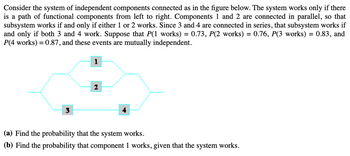
A First Course in Probability (10th Edition)
10th Edition
ISBN: 9780134753119
Author: Sheldon Ross
Publisher: PEARSON
expand_more
expand_more
format_list_bulleted
Question

Transcribed Image Text:Consider the system of independent components connected as in the figure below. The system works only if there
is a path of functional components from left to right. Components 1 and 2 are connected in parallel, so that
subsystem works if and only if either 1 or 2 works. Since 3 and 4 are connected in series, that subsystem works if
and only if both 3 and 4 work. Suppose that P(1 works) = 0.73, P(2 works) = 0.76, P(3 works) = 0.83, and
P(4 works) = 0.87, and these events are mutually independent.
1
2
(a) Find the probability that the system works.
(b) Find the probability that component 1 works, given that the system works.
Expert Solution
This question has been solved!
Explore an expertly crafted, step-by-step solution for a thorough understanding of key concepts.
Step by stepSolved in 2 steps with 2 images

Knowledge Booster
Similar questions
- 4. Use the SOR method with w = 1.2 to solve the linear systems 4x1 + x2 + X3+ Xs = 6, -x – 3x2 + x3 + x4 = 6, 2x, + x2 + 5xz – X4 - x5 = 6, -XI - x2 - X3 + 4x4 = 6, 2x2 - x3 + xX4 +4x3 = 6. with a tolerance TOL = 10-3 in the loo norm.arrow_forwardSolve the following system using the Gaussian algorithm: 2x1 - x2 + 3x3 = 0 -2x1 + x2 - X3 = -2 x1 - 3x2 + 6x3 = 3 Let x be the vector x = |x2, where x1, x2 and x3 are solutions of the system, and y be the vector y =|1 Evaluate the scalar product of x and y. [Please enter your answer numerically in decimal format. You will be marked correct as long as what you enter is within 0.25 of the correct answer. So for example, if the correct answer is 6.78 then any input that lies between between 6.53 and 7.03 will be marked as correct.] Answer:arrow_forwardSolve the following system using the Gaussian algorithm: 2x1 - x2 + 3x3 = 3 -2x1 + x2 – x3 = 0 x1 - 3x2 + 6x3 = 3 Let x be the vector x = x2l, where x1, x2 and x3 are solutions of the system, and y be the vector y = 1. Evaluate the scalar product of x and y. 0.arrow_forward
- Use naive-Gauss-elimination to decompose the following system. - 2x + 3y + z = 9 x + 2y + 3z = 6 3x + y + 2z = 8 %3D How can you test the system whether they will be convergent or not.arrow_forwardSolve the following system using the Gaussian algorithm: 2x1 – x2 + 3x3 = 0 -2x1 + x2 – X3 = -1 X1 — Зx2 + 6хз = 3 X1 Let x be the vector x = |x2, where x1, x2 and x3 are solutions of the system, and y be the vector y 1|. Evaluate the scalar product of x X3, and y.arrow_forward
arrow_back_ios
arrow_forward_ios
Recommended textbooks for you
 A First Course in Probability (10th Edition)ProbabilityISBN:9780134753119Author:Sheldon RossPublisher:PEARSON
A First Course in Probability (10th Edition)ProbabilityISBN:9780134753119Author:Sheldon RossPublisher:PEARSON

A First Course in Probability (10th Edition)
Probability
ISBN:9780134753119
Author:Sheldon Ross
Publisher:PEARSON
